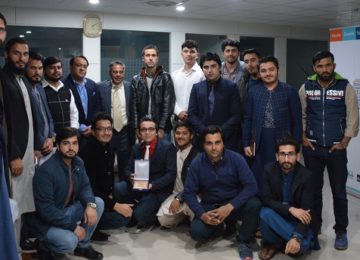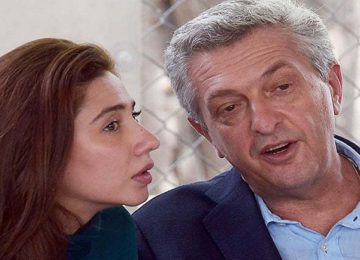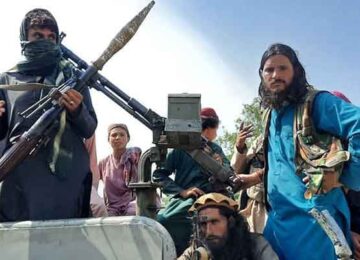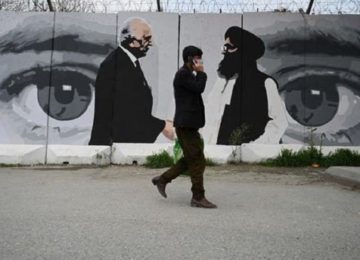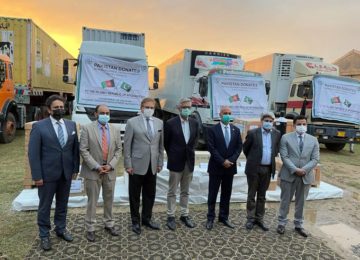For almost a year, more than half of Afghanistan’s cabinet members were in an acting minister capacity only, putting their legitimacy into question. In late November 2017, the President finally had 12 minister candidates introduced to parliament. They faced votes of confidence on 4 December 2017. All but one – the only woman – passed. Now, just three ministries remain to be led by acting ministers, with another ministry in an unresolved status.
The vote in the Wolesi Jirga
Previous votes of confidence in the Wolesi Jirga have been protracted, controversial affairs (see AAN analysis here and here). But this time, almost everything went quickly and smoothly. 12 candidates were introduced to the house by Second Vice President Sarwar Danesh on 25 November 2017. On 4 December, 11 of the 12 were voted into full office within hours. Among them were candidates for two key security cabinet posts. All had already been leading their respective ministries in an acting minister’s capacity, most of them, like Bahrami for the Defence Ministry, for months, although Dr Najibullah Khoja Omary (higher education) had only been in office for a few days. Many of their predecessors have been voted out of office by the Wolesi Jirga in late 2016 (AAN analysis here).
224 MPs were present in the 4 December session, so the candidates had to receive at least 113 votes to become a minister.
The only candidate who was unable to do so was the only woman in the group, Nargis Nehan, a former civil society activists nominated for the crucial mining and petroleum ministry. She received only 107 ‘yes’ votes. Another candidate, Shahzad Gul Aryubi for the Ministry of Telecommunication, cleared the threshold by just two votes. Along with Karimi (for agriculture) there are now two cabinet posts filled by south-eastern Pashtuns, a group that generally feels underrepresented at the central government level. (A long-serving predecessor of Aryubi’s, Amirzai Sangin, also came from the southeast.)
The candidate with the next lowest number of ‘yes’ votes was Faizullah Zaki, now Minister of Labour and Social Affairs. He is an Uzbek and known stalwart of the Jombesh party led by estranged First Vice President Abdul Rashid Dostum (see here) who is in Turkey officially for medical treatment; Uzbek candidates have previously regularly failed to win a majority in the house.
With Wais Barmak (Interior) and Tareq Shah Bahrami (Defence), the two candidates for security portfolios made it through securely. The same went for Gul Agha Sherzai for the touchy tribal and border affairs ministry that has historically had among its tasks keeping up relations with the Pashtuns and Baloch in Pakistan in what Afghans consider the country’s lost eastern territories, taken away in the British colonial times. As a former key mujahedin commander in the Kandahar region, a representative of Afghanistan’s warlord period has again become a minister. (The last one was Ismail Khan from Herat, who was Minister for Water and Power under Hamed Karzai.) With strong followings in eastern and southern Afghanistan – where he served as provincial governor of Kandahar and Nangrahar – Gul Agha’s appointment can be read as an attempt by the president to win over those potential voter bases for the upcoming presidential election. (In 2014, Gul Agha supported Abdullah.)
Another important election is that of new economy minister Muhammad Mustafa Mastur, until recently a long-standing deputy finance minister, well educated and seen as competent by many donors but also, as Chief Executive Abdullah Abdullah’s nephew, politically very well-connected.
The reasons why the Wolesi Jirga vote went comparatively smoothly are open to speculation. President Ashraf Ghani had openly warned candidates against making payments to or doing other deals with MPs. This had become a ‘tradition’ ahead of earlier votes (see this AAN report from 2010). This time, the president, was quoted in the Afghan media by his spokesman, Shah Hussain Murtazawi (who is also still acting), as saying that any candidate offering money “will be removed from the list of nominees.” Kandahar MP Khaled Pashtun told AAN he was surprised that “this time” there was no money handed out before the vote.
Another strong incentive was surely that parliamentary elections will soon be upon us, officially planned for July 2018 (or possibly later that year – see AAN analysis here). In that situation, candidates can be expected to avoid the wrath of the president who, if past elections are anything to go by, personally and through his apparatus, will play a key role in determining who will run and who gets his support. The president’s knowledge about government contracting (he personally chairs the National Procurement Commission, among other bodies) also gives him leverage over MPs (see the quotes about the ownership of mining and other companies below).
MP Assadullah Sa’adati from Daikundi told AAN that the smooth vote was also a reaction to a high-level opposition MPs meeting that was held in Kandahar on 2 December 2017. Balkh governor Atta Muhammad Nur claimed in a video posted online (see here) that the plane planned to carry him and acting Jombesh leader Bator Dostum had reportedly been prevented by “the government leadership” from reaching Kandahar. In Sa’adati’s interpretation, a number of MPs wanted to show by voting for the government’s candidates that the house was not controlled by this opposition alliance.
An analysis of the new ministers’ backgrounds also reveals that, unlike previous offerings of candidates, many are not easily identified with the two camps in the National Unity Government (NUG), that of President Ghani and Chief Executive Abdullah. With upcoming elections casting shadows ahead, the emergence of new ‘opposition’ groups (see AAN analysis here and here) and developments in Abdullah’s Jamiat party, the two camps have started to lose cohesion. Also, more professional candidates with less clear political affiliation have started to come in. So, the earlier much fought-over 50:50 formula for the distribution of government positions is losing importance and was not (or could not be) implemented anymore this time. (More biographical detail about the 12 candidates below.)
Vice President Danesh, when introducing the 12 prospective ministers in late November, said the candidates for the remaining open cabinet posts (Ministers of Education, Foreign Affairs, and Culture and Information) and three members of the Supreme Court would be introduced for a vote of confidence “in the near future.” He said the Afghan government had tried to find eligible candidates in the previous three days, but had failed to do so.
The case of the mining ministry
Narges Nehan’s rejection has been commented upon widely, with a number of observers pointing to widespread misogyny in a parliament (see example here) with strong conservative elements that has previously voted against women rights legislation such as the EVAW law (AAN analysis here). Women candidates have disproportionally been voted down by the Wolesi Jirga – in January 2015, after a similar vote, AAN wrote that “MPs rejected all the Hazara, Uzbek (the third and fourth largest ethnic groups respectively) and women candidates. However, this time, reported Hasht-e Sobh, women MPs did vote for Nehan, but the men did not.
But Nehan’s rejection is probably not only because of her gender or because, as two MPs told us, she was seen as too close to the president. The Ministry of Mining is a ministry with much to offer in the way of potential revenue for the country, contracts and opportunities for graft. Afghanistan’s mineral riches include “24 potential blockbuster deposits,” as the Journal Science put it. Those include the Ainak copper mine, the coal and iron mines in Hajigak and the gas fields of northern Afghanistan as well as gold mines in Baghlan and elsewhere, gem stones and still to be explored deposits of lithium and probably even uranium. So far, largely untapped, they are considered by many, including in the Afghan government and among its international allies, as the road out of Afghanistan’s economic crisis and to prosperity.
But many of the deposits lie in areas contested by the government, criminal networks and insurgent groups. (1) Some, such as Ainak, Hajigak and northern gas and oil field where tenders have been won by Chinese and Indian companies, continue to be fought over by foreign investors (see AAN reporting here and this recent Buzzfeed report). Also, according to a June 2017 USIP report, “industrial-scale looting” and “massive corruption” is already on-going in smaller Afghan mining operations.
The report’s authors says:
… prior political penetration of power holders and their networks in government, who became increasingly entrenched over time, explains this pattern of looting, which is engaged in with impunity owing to massive corruption of government agencies charged with overseeing the extractives sector, main highways, and borders. (…)
Mining companies that obtain contracts tend to be owned by politically connected per- sons, including, in many cases, members of the Afghan parliament (MPs), their family members, their associates, and power holders with access to armed groups and their networks. The beneficial ownership of mining companies—that is, who shares in the profits—tends to be hidden, particularly when shareholders are persons not allowed under law to have a contract with the government (as is the case for MPs).
In an earlier report, in 2015, USIP had criticised that the “decentralization of licensing for smaller mines to provincial mining departments has led to even greater corruption and secrecy.” Illegal extraction, “without any revenue coming to the government”, is estimated as happening at 1,400 sites.
This situation makes control over the mining and petroleum ministry highly lucrative – and, judging by the volatility of those sitting in the minister’s seat, a difficult post to occupy. There have been at least six ministers and three other acting ones since the downfall of the Taleban regime. One of them, Muhammad Ibrahim Adel, who had presided over the Chinese winning a number of key contracts, was toppled for alleged corruption, discovered by his US advisors (read here), while another, Juma Muhammad Muhammadi, died in an air crash in 2003. One of the longest serving ministers, Wahidullah Shahrani (2010-13), who, since his return to the country, had risen through important positions (Presidential Adviser on Economic Affairs, Deputy Head of the Central Bank, and Deputy Minister of Finance. Became Minister of Commerce in 2008 respectively) promised reforms and more transparency when coming into office and released details of a large number of mining and energy contracts in an effort to counter rampant corruption of government officials. But Global Witness, a non-government organisation specialising in world wide mining, still found in 2016 that of a “series of commitments to increase transparency (…) and reforming contracting, girded by a stronger legislative and regulatory framework (…), most of them remain to be implemented.” Also the resignation of the last full minister, Daud Shah Saba, in March 2016, remained officially unexplained. He had told AAN that he intended to concentrate on generating revenue from on-going medium-scale and small mining known for its particular susceptibility for looting and mafia and insurgent network control. Before his resignation, as Afghan media reported, he had complained about “curbs” on his authority and on mining contracts.
The appointment of reform-minded Nehan – who had previously shown her capabilities in various government positions including in the ministries of finance, education and higher education and as Vice Chancellor of Kabul University, responsibly for administration and finances (her official biography is here), overlapping with the current president in some of thoese institutions – must have been perceived as a threat by the ‘looters’. Immediately, after taking over in late March 2017, she announced she would work with civil society and in September 2017, she stated that most of the mining contracts signed in the past 15 years needed to be reviewed. Afghan and international civil society, that includes groups looking into mining (see here) had cautiously welcomed Nehan’s appointment, earlier this year. But unsurprisingly, there also were already allegations of corruption under her, as MPs told AAN – which could easily be baseless and part of the power struggle over the ministry.
The following candidate ministers have been elected (sorted by number of ‘yes’ votes)
The biographies use official biographies, data collections such as Afghan Bios and by Kabul daily Arman-e Melli as well as various AAN colleagues’ archives.
Wais Barmak: Minister of Interior
(173 yes, 35 no, 10 blank and 6 invalid votes)
Barmak, a Tajik from the Panjsher, has been acting Minister of Interior since 13 August 2017. He was the only candidate who served in President Karzai’s cabinet, as the Minister of Rural Development and Rehabilitation, from 2011 to 2013.
In the 1990s and into the early 200s, he worked with the International Committee of the Red Cross, ACBAR (the umbrella organisation of NGOs in Afghanistan), as senior programme officer, and as a senior official with UNDP. Under the National Unity Government (NUG), he worked for many years in the Ministry of Rural Rehabilitation and Development, as executive director of the National Solidarity Programme, senior advisor on disaster management, senior advisor to the minister, then as deputy minister and finally minister. Under the NUG, he has served as special envoy for the president for good governance and security and, from October 2015, as State Minister for Disaster Management and Humanitarian Affairs and head of the Afghanistan National Disaster Management Authority.
Barmak got his masters in development studies from the School of Oriental and African Studies at the University of London and his Bachelor of Architecture from Kabul University.
Gul Agha Sherzai: Minister of Borders and Tribes
(158 yes, 49 no, 12 blanked and 5 invalid votes)
Sherzai, ‘the lion’s son’, is rarely called by his real name, Muhammad Shafiq. He is the son of a famous mujahedin commander, Haji Abdul Latif, who was linked to Pir Gailani’s Mahaz-e Melli-ye Islami-ye Afghanistan (National Islamic Front of Afghanistan, or NIFA) which was loyal to the former king Muhammad Zaher Shah. He is a Barakzai Pashtun from Kandahar. Under the 1992-96 mujahedin government (and after his father’s assassination), he was the provincial governor of Kandahar and, at that time, had a relatively good name among Kandahari commanders. In 1994, he fled to Pakistan before the Taleban took over the province, and returned to the city in 2001, becoming Kandahar governor, once again, in 2002. He was one of the key allies of the United States especially the Special Forces in the south, and his behaviour towards those associated with the old regime, capturing them for US bounties, using torture and extorting money was one element which sparked the insurgency. (1)
Sherzai became too powerful for his fellow Kandahari, President Karzai and he moved him first, briefly, to the Ministry of Urban Development in 2004, and then to the governorship of Nangrahar province. A shrewd businessman, Gul Agha also projected himself as a philanthropist; he loved to see his name on project signboards that appeared all over the provincial capital, Jalalabad. Away from his original tribal base, he managed to establish a following in the east, too. At the same time, there were accusations against him of pocketing money in the name of construction projects, grabbing government land and being unable to protect the province from Pakistan inroads and shelling (AAN reporting here). When he stepped down in order to run in the 2014 presidential election (where he scored only 1.57 per cent of the vote), Nangrahar residents went on strike and blocked the main Torkham-Kabul highway in a show of support. In the election’s second round, he supported Abdullah, who reportedly also introduced him for this cabinet post.
Yama Yari: Minister of Public Works
(156 yes, 46 no, 17 blanked and 5 invalid votes)
A Pashtun from Herat province, Yari came to the UK in the late 1990s and gained a degree in engineering and a master degree in engineering and business management from UK universities. He worked as an engineer including on the railways in Britain, before returning to Afghanistan to be an advisor at the Ministry of Public Works in 2013. He was Director General of the National Procurement Authority and then Director of the National Procurement Office and is said to be close to the president.
Mustafa Mastur: Minister of Economy
(155 yes, 49 no, 10 blanked and 9 invalid votes)
A Tajik born in Kabul (his family is from Panjshir), he has a bachelor in medicine from Kabul University and a masters in business administration from Preston University in Pakistan and a masters in the science of health management from the London School of Tropical Hygiene. He worked with NGOs, including the Swedish Committee for Afghanistan, before taking up positions in the Ministries of Public Health and Finance, becoming a deputy minister of finance in 2014. Mastur is a nephew of Chief Executive Abdullah.
Muhammad Hamid Tahmasi: Minister of Transport,
149 yes, 55 no, 11 blanked and 9 invalid votes
Tahmasi is a Hazara from Ghazni Province, but is backed not by the traditional Hazara leaders, but President Ghani, his nomination also supported by Abdullah as a gesture to the mainly Hazara grassroots protest movement, the Enlightenment Movement (AAN background here).
Born in 1980, Tahmasi got bachelor and masters degrees in law from Kabul University in 2005 and a masters in criminal law from Kateb University, also in Kabul, in 2015. He served as a human rights officer with UNAMA, and worked in the Attorney General’s Office and the Independent Directorate of Local Governance (IDLG). He was the head of the Auditing Unit in the Presidential Administrative Office (2013-2015) and deputy minister of the Ministry of Interior for Equipment.
Nasir Ahmad Durrani: Minister of Agriculture
(144 yes, 63 no, 9 blanked and 8 invalid votes)
A Pashtun from Logar province, Durrani obtained an engineering degree from Kabul University in 1975, and in the 1980s, did postgraduate studies in mine management and prospecting in the Philippines and, worked for a steel mines company in Peshawar (as a refugee) in the mid-1980s, before going onto Nebraska University in the US. He has worked in the energy sectors in France and the UK. He returned to Afghanistan in 2009 and was appointed advisor to the Ministry of Economy and later deputy Minister of Mines. Durrani is associated with the Hezb-e Islami faction led by Abdul Hadi Arghandiwal (AAN background here) which allied itself with Dr Abdullah during the 2014 presidential election. He was appointed Minister of Rehabilitation and Development and gained the MPs’ vote of confidence in 2015. In September, the president moved him to the agriculture ministry.
Tareq Shah Bahrami: Minister of Defence
(141 yes, 65 no, 9 blanked and 9 invalid votes)
Serving as acting minister since June 2017, Lieutenant General Bahrami, who is from Laghman, has a military, PDPA-era background. He holds a BA from the Kabul Military Academy and served as deputy company commander (1986), then commander and deputy battalion commander (1988 to 1989). A senior army officer told AAN that Bahrami spent the mujahedin and Taleban years in the Netherlands. After 2001, he returned to Afghanistan to serve in a variety of jobs in the interior and defence ministries, including 201st Corps Commander (2003 to 2008), commander of the 444 Commando Forces Unit in Helmand Province (2009 to 2012) and General Manager of Planning and the Operations Director for Special Forces unit in the Ministry of Interior in 2012. In 2015, he became the director of the National Coordination Centre in the National Security Council (NSC) and in March 2017 senior deputy minister for security affairs in the interior ministry. Bahrami holds a masters from the Advanced Command College in the UK.
Bahrami supported President Ghani during the 2014 presidential election.
Mujib Rahman Karimi: Minister of Rural Development
(129 yes, 76 no, 9 blanked and 10 invalid)
Karimi, a Pashtun from Khost province, was born in 1977 and has a degree in agriculture from Kabul University and a masters degree in development planning from the Asian Institute of Technology in Thailand. Karimi worked as a trainer and manager in the National Solidarity Programme in the Ministry of Rural Development (2003 to 2007) and UNAMA field officer in Khost (2007 to 2012). He also worked as a professor and head of the agriculture facility in the Shaikh Zahid University in Khost (2003-2013) where he was appointed dean in 2015.
Faizullah Zaki: Ministry of Labour, Social Affairs, Martyrs and Disabled
(126 yes, 75 no, 9 blanked and 13 invalid votes)
An urbane Uzbek, born in 1958 in Jowzjan province, Zaki holds a bachelor degree in geology from Kabul University and later in worked in journalism. He made it from communist youth functionary (DYOA head for Kabul in the 1980s) to deputy leader of Jombesh, a non-mujahedin tanzim, ie the military-political network established and led by now First Vice President Abdul Rashid Dostum. He left Afghanistan in the early 1990s and worked for a family firm in Uzbekistan. Zaki became one of the major proponents of reforming and democratising Jombesh (background in this AAN paper), representing its non-commander wing and pro-federalism current. He comfortably won a Wolesi Jirga seat from Jowzjan in 2005, where he was far ahead of all other candidates with 20.6 per cent of the vote. When planning to run for a parliament seat in 2010, Dostum and nominal Jombesh leader Nurullah (who had his own ambitions to serve as an MP, but lost) stopped him, fearing he might become too independent. Zaki has served as deputy party chair.
MPs rejected him as nominee for the Ministry of Transport and Civil Aviation in 2015. In 2016, he was appointed as Deputy National Security Advisor (NSA) in 2016. He was a supporter of Ghani in the 2014 elections and one of his spokesmen.
Najibullah Khwaja Omari: Minister of Higher Education
(124 yes, 77 no, 13 blanked and 10 invalid votes)
Khawja Omari, who is a Hazara from Ghazni province and a relatively new face, was only appointed as acting minister of higher education on 22 November 2017. He has a masters degree in engineering and has served as Vice President of Bakhtar University in Kabul with various international NGOs and the World Bank and in the NSC as an advisor. Last time he did not get the vote of confidence to remain the minister because it was said that he did not possess a degree.
Shahzad Gul Aryubi: Minister of Communications and Information Technology
(115 yes, 81 no, 22 blanked and 6 invalid votes)
A Pashtun from the Aryubi district of Khost province, Aryubi has a degree from Pakistan. He has worked in various UN offices since 2000 and in USAID, the World Bank and the Ministry of Tribal Affairs and in 2015, he was appointed general director of Asan Khedmat (“easy service”) in the Finance Ministry: this is the so-called ‘one stop shop’ that will eventually bring all interactions between government and public under one roof, including getting licenses, IDs and passports and paying taxes
Not elected
Nargis Nehan: Ministry of Mines and Petrolium
(107 yes, 93 no, 15 blanked and 8 invalid votes)
Nehan holds a master’s degree in business management and has received international training in the areas of leadership, result-based budgeting, gender budgeting, strategic planning, good governance, peace building and conflict resolution. She worked as the director of treasury in the Ministry of Finance in the early years of the Karzai administration, when Ghani was minister. She was also , Vice Chancellor of Kabul University at the Administration and Finance Department. Nehan has served as senior advisor both to the finance department in the Ministry of Education and to the planning department in the Ministry of Higher Education. She has been a member of the Civil Society Joint Working Group (CS-JWG), the Afghan Coalition for Transparency and Accountability (ACTA), and the Supreme Council of the Central Bank of Afghanistan – where she was the first ever woman member. In 2007 she co-authored a book with Ghani, “The budget as a Linchpin of the State: Lessons from Afghanistan.” She supported Ghani in the 2014 elections.
Edited by Kate Clark
(1) This was the case under both the previous and the current US governments (see here and here). The Pentagon even ran a Task Force for Business and Stability Operations in Afghanistan that, according to a RAND study dealt with “managing projects, identifying resources, contracting negotiations, and providing legal representation for the Afghan government.” The Task Force itself came under criticism from interested parties:
How was CNPC [the China National Petroleum Corp.] able to win a tender for such a strategic resource [oil fields in the Amu Darya basin in northern Afghanistan] in a country where the United States wields tremendous influence? Amazingly, one reason is that the U.S. Defense Department, whose Task Force on Business and Stability Operations, which is charged with resuscitating the economies of Afghanistan and Iraq, designed and oversaw a tender process that played to the strengths of Chinese state-owned companies over Western private ones.
Read a SIGAR report pointing out other shortcomings of the task force’s here.
(2) Anand Gopal wrote in “The Battle for Afghanistan: Militancy and Conflict in Kandahar” published by the New American Foundation in November 2010:
The alienation of leading former Taliban commanders in Kandahar would become a key motivating factor in sparking the insurgency there. Kandahar’s governor, Gul Agha Sherzai, had initially taken a conciliatory attitude toward former Taliban figures. But his close ties with U.S. special forces, who often posted rewards for top Taliban leaders, as well as isolated attacks against the government and the possibility of exploiting his position for financial gain, eventually led to a retaliatory approach. The provincial government began to harass former Taliban commanders, usually mid-level military figures, who had remained behind in Kandahar. A group of Sherzai’s commanders— Khalid Pashtun, Zhed Gulalai, Karam, Agha Shah, and others—became synonymous with abuse. Some of these men had a role in provincial government: Khalid Pashtun was Sherzai’s spokesman, for example, and Karam was an official of Afghanistan’s intelligence agency, the National Directorate of Security (NDS).
These commanders targeted men formerly associated with the Taliban, often torturing them in secret prisons, according to numerous tribal elders, government officials, and Taliban members.
By Special Arrangement with AAN. Original link.
Disclaimer: Views expressed on this blog are not necessarily endorsed or supported by the Center for Research and Security Studies, Islamabad.




